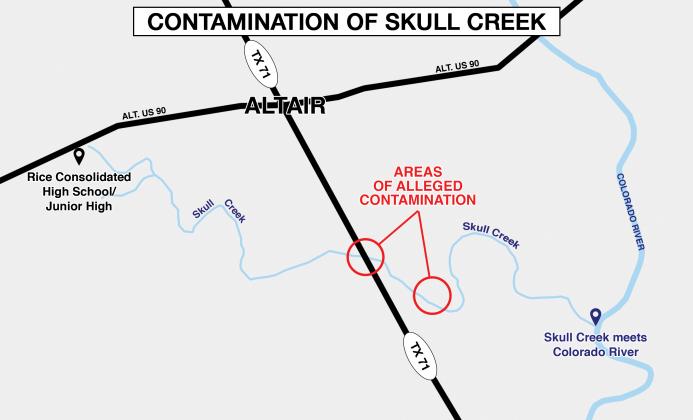Black water, dead fish after contamination in Skull Creek
Water as black as India ink, scores of dead fish, and noxious odors greeted environmental regulators and law enforcement at Skull Creek last week as the county and state agencies grapple with what may be the worst environmental calamity Colorado County has experienced in at least a decade.
ALTAIR—Water as black as India ink, scores of dead fish, and noxious odors greeted environmental regulators and law enforcement at Skull Creek last week as the county and state agencies grapple with what may be the worst environmental calamity Colorado County has experienced in at least a decade.
An investigation in to the incident has been ongoing since last week, Colorado County Judge Ty Prause said.
“It has been reported me to me that it [the contamination] goes all the way to the [Colorado] river,” Prause told The Citizen.
What, specifically, the oily, black discharge is, no one can—or will—say for certain. The Texas Commission on Environmental Quality, the state’s environmental regulator, will only say the matter is under investigation.
“The TCEQ received notification regarding a spill and fish kill on Feb. 8. The TCEQ is coordinating with Texas Parks and Wildlife and the Texas Railroad Commission to evaluate the situation,” said Andrea Morrow, Public Information Specialist with the agency.
TPWD confirmed the fish kill and sheen on the water in a statement to The Citizen.
“The Texas Parks and Wildlife Department Kills and Spills Team received a call from the Texas Commission on Environmental Quality Feb. 8 at 6 p.m. regarding a sheen and several dead fish in Skull Creek near Highway 71,” said Aubry Buzek, press officer for TPWD.
“KAST conducted an investigation on Feb. 9 and observed approximately 25 dead fish at Skull Creek and Hwy 71 near ... Altair. The water was a dark gray color with visible sheen and what appeared to be a weathered petroleum product in some areas between Hwy 71 and the confluence with the Colorado River,” she continued.
“There was also a moderate to strong chemical or petroleum odor present at the Hwy 71 bridge. KAST has reported their findings to TCEQ and the Texas Railroad Commission,” she continued.
The Texas Railroad Commission, one of the other agencies involved in the investigation, did not return calls for comment prior to deadline.
“When you see dead fish, that’s more than just a little petrochemical byproduct or something that has migrated into the creek, that wouldn’t be harmful to human lives or animals,” Prause said.
“I am greatly concerned,” Prause said.
Jim Brasher, Executive Director of the Colorado County Groundwater Conservation District said there were two components of the contamination--potential for damage to surface water and potential for damage to groundwater.
“If it is going in to surface water--a creek--it has the chance to get in to rivers and contaminate that water supply. We rely on the [Colorado] river for irrigation and all sorts of uses,” Brasher said. “This also has potential to leach down into the subsurface and get into the aquifer,” he said.
“That would directly affect drinking water or water for livestock,” Brasher continued.
In at least the last decade, Brasher said he was unaware of any environmental calamity in the county that reaches the proportions of the Skull Creek spill.
What exactly caused the oily, black discharge in Skull Creek from the point the creek intersects Texas Highway 71 as far east as the point that intersects Colorado County Road 16 isn’t known.
One state agency water quality specialist, however, has “deduced there is some discharge occurring in the area where an existing oil and gas waste landfarm is located.”
This revelation came in an email from Susan Meckel, Water Quality Coordinator with the Lower Colorado River Authority, sent last week to one of several county residents who reported the conditions at Skull Creek to various state agencies and The Citizen.
At least one company, Inland Environmental & Remediation, operates a site in the area that is regulated by the Texas Railroad Commission, one of the agencies investigating the pollution.
Officials with Inland Environmental declined to comment for this story when reached Monday afternoon.
No agency investigating the matter has publicly identified the party responsible for the contamination.
“At this time they have not determined a responsible party or direct source of the material. The investigation is ongoing and further site visits are planned this week. EPA and the Office of Emergency Management have been notified, said TPWD’s Buzek.
One local water quality expert who visited the site Friday, and spoke to the newspaper on the condition of anonymity because he was not specifically authorized to speak on the matter, said the contamination looked and smelled like petrochemical or hydrocarbon contamination.
Several gravel pit operations are also in this area.
Prause said the issues with odors and an oily sheen on areas of Skull Creek isn’t a new concern, although the current situation is more severe. Prause said residents in the area have been reporting these issues to him for “probably the last five years.”
Drone video shot of the area, as well as photos provided to the newspaper by individuals who have visited various contamination sites along the creek show water that is dark black in places, numerous dead fish and, in some spots, a rainbow-esque sheen similar to that seen when motor oil mixes with water.
Brasher with the groundwater conservation district says local residents should be very concerned about the damage to the water supply.
“It is significant enough we need to worry about it as a county,” Brasher said. He noted that the local groundwater conservation district has no authority to address polluters, and that local authorities must depend on state agencies to act.
“You hope that they’re out there paying attention to this, and doing their job,” he said. “This needs to be addressed,” he continued.
Skull Creek begins just east of Rice Consolidated High School on US 90 Alternate, and zig-zags in eastward and southerly directions before it crosses Texas 71 approximately 13 miles from downtown Columbus. The creek then flows north and back southeast before meeting the Colorado River at the second bend north of the terminus of County Road 157.
According to The Handbook of Texas, “Skull Creek rises in the central western portion of Colorado County (at 29°40' N, 96°44' W) and runs east for eighteen miles to its mouth on the Colorado River, near Altair (at 29°31' N, 96°24' W).”
The creek has long played a dominant role in local lore and history.
Early settler Jesse Burnam cited the creek as the site of an early battle between white settlers and the indigenous Karankawa tribe in 1823.
State agencies were not able to provide details on remediation, contents of the contamination, or timelines to complete their investigations, all of which remain ongoing, according to county officials.

